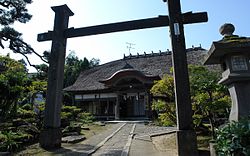



Ashukubo (宿坊) is a temple lodging in Japan that allows visitors to stay overnight within a Buddhist temple.[1] Originally, these facilities were designed to accommodate only monks and worshippers, but nowadays, in response to declining numbers of monk visitors, most facilities accept general tourists.[2] Some temples, such as Mount Kōya, have open-air baths with onsen.[3] Shukubo are now considered semi-secularized and in many towns are the only accommodations available.[3]
Originally, shukubo were used by bhikku and confraternities,[2][failed verification] and later by lay practitioners of Shugendō and mountain worship, and played major roles in the development of the latter two.[4] At the foot of Mount Haguro there were once 336 shukubo all linked to Shugendō.[5]
Networks of shukubo began[when?] to develop in Ise, Shima, Toba, and Futami-ura in a decades long construction boom.[6]
In the Edo period, visits to temples and shrines became popular, including visits to Ise, Kotohira-gū, and Zenkō-ji. Lodging houses were built at major temples and shrines in each area to accommodate ordinary pilgrims and tourists, forming a kind of tourism business, with specific areas connected to specific lodging houses.[3]
In modern times, some shukubo have been converted into traditional inns and ryokan for tourists who want to experience the atmosphere of a temple.[7][failed verification] Many modern-day operators of shukobo are descendants of families that ran shukubo when they were a purely religious matter. Originally, they only operated for one kosha but opening to the general public has substantially increased amounts of people staying at shukubo.[2]